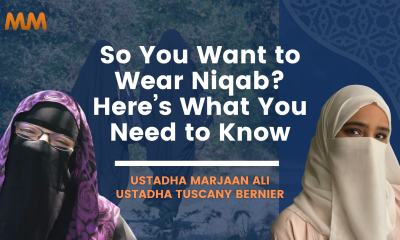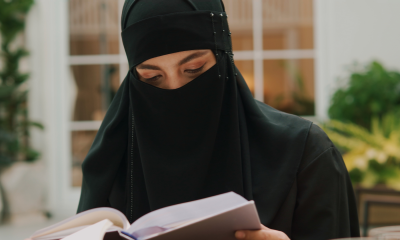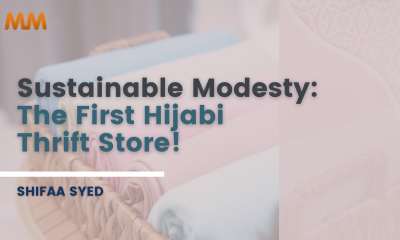News and Views
Kentucky Kernel: ‘Undercover’ in hijab: unveiling one month later
Published
By
AmirHilton Als, an African American writer, says our worldview and sense of “otherness” is created in our mother’s lap.
Mother’s lap is protective and familiar. Leaving this worldview can be uncomfortable, but I can assure you, the rewards are much greater.
Hijab
Last month, I climbed out of my “lap” and wore a hijab, the Muslim headscarf. I thought this temporary modification of my appearance would bring me closer to an understanding of the Muslim community, but in retrospect, I learned more about my place in the world.
Keep supporting MuslimMatters for the sake of Allah
Alhamdulillah, we're at over 850 supporters. Help us get to 900 supporters this month. All it takes is a small gift from a reader like you to keep us going, for just $2 / month.
The Prophet (SAW) has taught us the best of deeds are those that done consistently, even if they are small. Click here to support MuslimMatters with a monthly donation of $2 per month. Set it and collect blessings from Allah (swt) for the khayr you're supporting without thinking about it.
Simplified, one piece of fabric is all it takes to turn perspectives upside-down.
The hijab is a contested, sacred and sometimes controversial symbol, but it is just a symbol. It is a symbol of Islam, a misconstrued, misunderstood religion that represents the most diverse population of people in the world — a population of more than one billion people.
I realized the best way to identify with Muslims was to take a walk in their shoes. On Oct. 1, I covered my head with a gauze scarf and grappled with the perceptions of strangers, peers and even my own family.
Because of perceptions, I even struggled to write this column. My experience with the hijab was personal, but I hope sharing what I saw will open a critical conversation.
My hijab silenced, but simultaneously, my hijab brought unforgettable words.
Idea
In the first column I wrote this semester, I compared college to an alarm clock saying, “we see the face of a clock, but rarely do we see what operates behind it.” At the time, I did not realize how seriously I needed to act on my own words — as a journalist, a woman and a human.
A few weeks after I wrote that piece, a guest columnist addressed Islamophobic sentiments regarding the proposed “ground zero” mosque. The writer was Muslim, and she received a flurry of feedback.
The comments online accumulated like a swarm of mindless pests. The collective opinion equated Islam to violence and terrorism.
In response to her column, one comment said, “[The writer] asks us to trust Islam. Given our collective experience, and given Islam’s history I have to wonder what planet she thinks we are on.”
Although I did not know the voices behind these anonymous posts, I felt involuntarily linked to them — because I am not Muslim. I wanted to connect people, and almost instinctively, I decided that a hijab was necessary. A hijab could help me use my affiliation with “white,” non-Muslims to build rapport with the Islamic community and at the same time, show non-Muslims the truth from an unheard voice. Above all, I wanted to see and feel the standard lifestyle for so many women around the world — because I’m curious, and that’s why I’m a journalist.
Before I took this step, I decided to propose my idea to the women who wear headscarves every day. Little did I know, a room full of strangers would quickly become my greatest source of encouragement and would make this project more attainable.
The handshake
Initially, I worried about how the Muslim community would perceive a non-Muslim in a hijab, so I needed its approval before I would start trying on scarves. On Sept. 16, I went to a Muslim Student Association meeting to introduce myself.
When I opened the door to the meeting room, I was incredibly nervous. To erase any sign of uncertainty, I interjected to a girl seated across the room, “meeting starts at 7, right?” The girl, it turns out, was Heba Suleiman, the MSA president. After I explained my plan, her face lit up.
“That is an amazing idea,” she said.
I felt my tension and built-up anxiety melt away. In the minutes following, I introduced myself to the whole group with an “asalaam alaykum,” and although I was half-prepared for it, I was alarmed to hear dozens of “wa aylaykum asalam” in response.
Before I left, several girls approached me. I will not forget what one girl said, “this gives me hope.” Another girl said, “I’m Muslim, and I couldn’t even do that.” It did not hit me until then, that this project would be more than covering my hair. I would be representing a community and a faith, and consequentially, I needed to be fully conscious of my actions while in hijab.
First steps “undercover”
Two weeks later, I met Heba and her friend Leanna for coffee, and they showed me how to wrap a hijab. The girls were incredibly helpful, more than they probably realized. Although this project was my personal undertaking, I knew I wouldn’t be alone — this thought helped me later when I felt like ripping off the hijab and quitting.
Responses to my hijab were subtle or nonexistent. I noticed passing glances diverted to the ground, but overall, everything felt the same. Near the end of the month, a classmate pointed out that a boy had been staring at me, much to my oblivion. The hijab became a part of me, and until I turned my head and felt a gentle tug, I forgot it was there.
For the most part, I carried out life as usual while in hijab. I rode my bike and felt the sensation of wind whipping under my headscarf. I walked past storefront windows, caught a glimpse of a foreign reflection and had to frequently remind myself that the girl was me. Hijab became part of my morning routine, and on one morning I biked to class and turned around because I realized I left without it. At the end of the day, I laughed at my “hijab hair” pressed flat against my scalp.
The hijab sometimes made me uneasy. I went to the grocery store and felt people dodge me in the aisles — or was that just my imagination?
I recognize every exchange I had and every occurrence I report may be an assumption or over analysis because few of my encounters were transparent. The truth is, however, very few of my peers said anything about the hijab. My classmates
I’ve sat next to for more than a year, my professors and my friends from high school — no one addressed the obvious, and it hurt. I felt separated from the people who know me best — or so I thought.
A gap in the conversation exists, and it’s not just surrounding my situation.
Just over a week ago, I turned on the news to see Juan Williams, a former NPR news analyst fired for commentary about Islam. Williams said, “If I see people who are in Muslim garb and I think, you know, they are identifying themselves first and foremost as Muslims, I get worried. I get nervous.”
His statement revealed an internalized fear. And I saw this fear when my colleagues dodged the topic. When I went back to ask “why?,” several said it was too “touchy” or insensitive to bring up.
A hijab is a just symbol, like a cross, a star or an American flag. I am still the same Cassidy Herrington — I didn’t change my identity, but I was treated like a separate entity.
Talk is not cheap
When someone mentioned my hijab without my provocation, I immediately felt at ease. A barista at my usual coffee stop politely asked, “Are you veiling?” A friend in the newsroom asked, “Are your ears cold?”
My favorite account involves a back-story.
I love Mediterranean and Middle Eastern cuisine, and I garnered an appetite when I was young. My childhood home neighbored my “third grandmother,” the most loving second-generation Lebanese woman and exceptional cook (not an exaggeration, she could get me to eat leafy vegetables when I was a child zealot of noodles and cheese). I remember knocking on her back door when I was five, asking for Tupperware brimming with tabouleh.
When King Tut’s opened on Limestone, my school year swiftly improved to a fabulously garlicky degree. At least once a week, I stopped by to pick up the tabouleh, hummos or falafel to medicate my case of the newsroom munchies.
On Oct. 21, the owner, Ashraf Yousef, stopped me before I went inside.
“I heard about your project, and I like it,” he said. “And you look beautiful in your hijab.”
This encounter was by far the best. And it made my shawarma sandwich taste particularly delicious. I went back on my last day to thank him, and Yousef said, “I’m just giving my honest opinion, with the hijab, you look beautiful. It makes your face look better.”
Yousef asked if I would wear the hijab to his restaurant when the project was over. I nodded, smiled and took a crunchy mouthful of fattoush.
False patriotism
I did not receive intentional, flagrant anti-Muslim responses. I did, however, receive an e-mail allegedly “intended” for another reader. The e-mail was titled “My new ringtone.” When I opened the audio file, the Muslim prayer to Mecca was abruptly silenced by three gunshots and the U.S. national anthem.
I spoke to the sender of the e-mail, and he said, “It was just a joke.” Here lies a problem with phobias and intolerance — joking about it doesn’t make it less of an issue. When was it ever okay to joke about hatred and persecution? Was it acceptable when Jews were grotesquely drawn in Nazi cartoons? Or when Emmet Till was brutally murdered?
The e-mail is unfortunate evidence that many people inaccurately perceive Islam as violent or as “the other.” A Gallup poll taken last November found 43 percent of Americans feel at least a “little” prejudice against Muslims. And if you need further confirmation that Islamophobia exists, consult Ann Coulter or Newt Gingrich.
Hijab-less
I’ve been asked, “Will you wear the hijab when it’s over?” and initially, I didn’t think I would — because I’m not Muslim, I don’t personally believe in hijab. Now that I see it hanging on my wall and I am able to reflect on the strength it gave me, I think, yes, when I need the headscarf, I might wear it.
Ashraf said, “A non-Muslim woman who wears a hijab is just wearing a headscarf.” (and apparently, my face “looks better.”) Appearances aside, when I wore the hijab, I felt confident and focused. I wore the hijab to a news conference for Rand Paul, and although an event coordinator stopped me (just me, except for one elusive blogger) to check my credentials, I felt I accurately represented myself as an intelligent, determined journalist — I was not concerned with how I looked, but rather, I was focused on gathering the story.
So now, I return to my first column of the year. I’ve asked the questions, and I’ve reached across the circles. Now, it’s your turn. You don’t have to wear a hijab for a month to change someone’s life or yours. The Masjid Bilial Islamic Center will host a “get to know your neighbors” on Nov. 7, and UK’s Muslim Student Association is having “The Hajj” on Nov. 8. These are opportunities for non-Muslims to be better informed and make meaningful connections.
I want to thank Heba for being a friend and a resource for help. Thank you to Ashraf Yousef and King Tut for the delicious food and the inspiration. Finally, I apologize to the individuals who feel I have “lied” to them about my identity or who do not agree with this project. I hope this page clears things up — you have the truth now, and I hope you find use for it.
Why are we so afraid to talk about this? We are not at war with Islam. In fact, Muslim soldiers are defending this country. Making jokes about terrorism is not going to make the situation less serious. Simply “tolerating” someone’s presence is not enough.
If you turn on the news, you will inevitably hear the prefix, “extremist,” when describing Islam. What you see and hear from the media is fallible — if you want the truth, talk to a Muslim.
Cassidy Herrington is a journalism and international studies junior. E-mail cherrington@kykernel.com.
Source: Kentucky Kernel
Keep supporting MuslimMatters for the sake of Allah
Alhamdulillah, we're at over 850 supporters. Help us get to 900 supporters this month. All it takes is a small gift from a reader like you to keep us going, for just $2 / month.
The Prophet (SAW) has taught us the best of deeds are those that done consistently, even if they are small. Click here to support MuslimMatters with a monthly donation of $2 per month. Set it and collect blessings from Allah (swt) for the khayr you're supporting without thinking about it.
Muslim American born in Brooklyn, NY with Guyanese parents currently living in Virginia working full-time as a web developer.


Faith And Algorithms: From An Ethical Framework For Islamic AI To Practical Application

Quebec Introduces Bill To Ban Prayer Rooms On College Campuses

Far Away [Part 2] – Alone

Restoring Balance In An Individualized Society: The Islamic Perspective on Parent-Child Relationships

The Limits Of Obedience In Marriage: A Hanafi Legal Perspective

Op-Ed – When Islamophobes Try To Intimidate Us, They Underestimate Our Resolve: A Call to Stand With America’s Muslim Students

Who’s Afraid Of Dr. Naledi Pandor? – Zionist Panic and a Visa Revoked

The Hunger Crisis: Reflections Of An American Muslim

Ahmed Al-Ahmed And The Meaning Of Courage

Moonshot [Part 31] – Stranger By The Day

[Dhul Hijjah Series] Calling Upon the Divine: The Art of Du’a (Part 1)

IOK Ramadan 2025: Four Steps | Sh Zaid Khan

IOK Ramadan 2025: Do Your Best | Sh Zaid Khan

IOK Ramadan 2025: Giving Preference to Others | Sh Zaid Khan

IOK Ramadan 2025: Which Group Are We In? | Sh Zaid Khan
Trending
-
#Life4 weeks ago
Op-Ed – When Islamophobes Try To Intimidate Us, They Underestimate Our Resolve: A Call to Stand With America’s Muslim Students
-
#Current Affairs4 weeks ago
Who’s Afraid Of Dr. Naledi Pandor? – Zionist Panic and a Visa Revoked
-
#Current Affairs1 month ago
November 29 Is The International Day Of Solidarity With The Palestinian People – What Will You Do?
-
#Society1 month ago
Op-Ed: What Muslims Will Really Be Talking About Over the Halal Turkey This Thanksgiving












Amir (MR)
November 1, 2010 at 5:01 PM
Email her and thank her for this piece:
cherrington@kykernel.com.
ai
November 2, 2010 at 3:24 AM
Very interesting.
Murabitun Takruri
November 6, 2010 at 8:32 PM
Salam,
Thank you Cassidy for taking the personal journey in someone elses shoe to understand and show the problem of hatred and anti-musilm or Islam that exists. I believe that Allah guided you to partake in this way and to do a project of this sort. I understand that now you have a different views about the hijab and muslim women who wear the hijab. If only the non-muslims were as curious, objective, rational and sensable as you there will be less of anti-muslim or anti-Islam in the west.
salam
Khadijah
January 8, 2011 at 6:51 AM
I converted to Islam in September 2010, and began wearing the hijab (headscarf) shortly after. I put it on after leaving my home and before entering, because my family is very religious Christians and I couldn’t tell them about my conversion. I lived in stereotypical American suburbia, about an hour north of Boston, and I was somewhat nervous, somewhat excited to see what the result would be.
You wrote, “The truth is, however, very few of my peers said anything about the hijab. My classmates
I’ve sat next to for more than a year, my professors and my friends from high school — no one addressed the obvious, and it hurt. I felt separated from the people who know me best — or so I thought. A gap in the conversation exists, and it’s not just surrounding my situation.” This was exactly my experience. Professors I had known for several years at college said absolutely nothing. The students in my class, to whom the change had to be overly conspicuous, said nothing. Friends who knew me well, Christian friends even, said nothing. But you could feel the unasked questions in the air. Shopping at the mall brought stares, not disdainful ones, but more of dumb ignorance, as though a penguin were walking past, and they weren’t sure what it was, what it was called, what to make of it, why it was there, and why it didn’t go back to where it came from. The reactions were not much different in fact, from those I received from my accent and nationality – more ignorance than hostility. And thankfully, the hijab also brought friendly greetings of assalamo alaikom from other Muslims.
Overall though, I can’t say there was any negative feedback. When one student finally asked about it, we entered into a long friendly discussion about religion in general. My conversion became more widely known among my college acquaintances, and completely accepted. When I “ran away” to Egypt in December 2010, I decided to begin wearing the niqab/burqa, covering the entire body, hands, eyes, everything. Though no longer physically present in America, the reactions I received from my American acquaintances, Christians in particular, were far more dramatic, and the questions and comments poured in on my Facebook profile photo and in my inbox. Does your husband force you to wear that? Do you have to wear it for the rest of your life? Will we ever see your face again? Isn’t it horrible and confining? How do you eat with it?? You look like you’re wearing a bag. It’s hideous, horrible, how can you wear that? Perhaps it’s easier to be more vocal in written than in person. Yet the non-Christian friends who had at first supported me, remained silent.
I asked my husband (a Muslim Egyptian) if I should wear it when we go back to America. He said yes, why not? And yet I’ve never seen a single woman wearing the niqab in America, not even on the media. I was there, and even had I not been able to guess people’s mental reactions, I see it every day in the messages that continue to pour into my inbox from concerned family and friends. I am viewed as an oppressed woman, forced to bury my face and identity in this material. I have no idea what the reactions will be when I wear it in America. But I know what people will be thinking, and that frustrates me. Because to me, the niqab is a liberating choice. When I wear it, I am not judged for my appearance, but by my character, my speech. It reflects modesty and gentleness, a concept called ‘haya’ that gives a woman true beauty. Men are not tempted to think wrongly when they see me. My beauty is a gift only for my husband, not for every man on the street. These are concepts so foreign to western promiscuity, and yet Americans pride themselves on the freedom and tolerance of their country – why won’t they tolerate the freedom of the niqab?
Mantiki
January 8, 2011 at 9:19 PM
What makes me uncomfortable Cassidy is that religious attire of any faith (not religious symbols) is an “in your face” reminder that such people consider that God has ordered people to dress and act in trivial and highly specific ways. This offends me because I don’t believe God desires to treat us as children who need such instruction over ALL facets of their lives. Related to this is the rational implication that if I choose not to follow such direction over trivialities, then some zealot will wrongly conclude that I dislike God or am disobedient and take it upon themself to punish me (or my sister) for this purely imaginary “blasphemy”. There are only 2 matters of importance for humans under God. 1 – love God, and 2 love your neighbour.
Sure people should wear whatever modest clothing they desire. But lets not pretend that God considers modesty to be important in its own right. It (modesty) is simply a way to protect the dignity of the wearer in a situation where immature or dangerous men might harm a woman through their desire for selfish gratification.